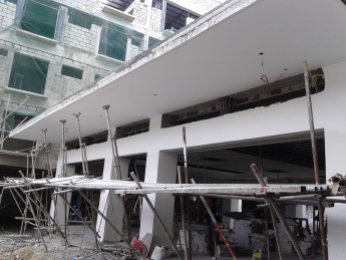Young architects are thinking and dreaming green. One of them is AARON SALAMAT, 24 years old from Silangang, Sta. Maria Bulacan. After working at project management in Boracay, designing for a Makati-based company and learning at an interior design firm for the last 3 years, Aaron has decided to set up his own company called RVA Design and Build.
Together with partners who specialize in plumbing, electrical, mechanical work and design, he is ready to turn his vision into reality, as he bids for a 4-floor mixed use building.
Going Green an Architects Responsibility:
Aaron believes that as an architect, you have a responsibility to build for the people inside and outside the building. He goes on to explain that the building is part of the environment, and affects the atmosphere and mood of those working inside it and walking outside the premises. “Maganda nga yung loob pero paano naman ang nasa labas?” (The interior environment is nice but what about the outside environment?”
“Sana mas dumami yung green buildings. (I hope there are more green buildings) When I first went to GK Enchanted Farm I was really impressed with the design of the Hyundai Center for Green Innovation.” His favorite building and inspiration sports wide windows and doorways for natural ventilation plus indigenous material in the ceiling – native sawali, that help cool the building and give it a homey feel. This makes it perfect for talks and events for schools and corporations.



Aaron hopes he can design something similar in the future, as his inspiration lives on in his hometown.
Architects have a massive scope and critical role in designing buildings and landscapes, and so it’s important that they build for people and the environment, because ultimately, the environment is also for the people. “When you build, it’s not just for money, but it’s for all,” Aaron shares passionately in our interview. “Architecture can change the environment of a town, city and the country.”
When I asked him about specifics of going green in architecture, Aaron started to discuss ventilation. Many buildings in the country are inefficient in keeping cool. Many use air-conditioning which produce a lot of carbon that heats up the atmosphere and is also expensive electricity wise. Aaron suggested incorporating natural ventilation into his designs, so that the building can cool naturally harnessing the wind and keeping in mind the angles of the sun.
Another strategy was to use bright color of paint on the roof, specifically the color white which can reflect up to 70% of the sunlight. This method was proven effective, as the polar ice caps which are mostly white with snow, are very effective as reflecting light and heat. The darker the color becomes, the more the surface absorbs heat.
Using LED lights can also save electricity and generate less heat. Another option was to use indoor plants, which would be incorporated into his design as he ensures enough sunlight hits the greens. Solar panels also provide a strong green backbone to any project. Although they may cost more initially, the long term savings are sizable. Finally, Aaron mentioned that glass can also absorb a lot of heat, and so needs to be treated properly so that it remains cooler.
Including sustainability into rural and urban design is something that everyone can do. If done well, Aaron believes that its goodness can spread like a virus and really improve our environment.
Favorite Construction Materials
Aaron’s orientation for the environment also affects his preference in materials. As much as possible he wants to mimic nature and use natural/indigenous materials such as wood, bamboo, etc. However, he knows that there is only 3% primary rainforest left in the Philippines, which drives the price of wood up and understands that he will have to look for alternatives to these items until such time that the country can establish a sustainable supply.
A simple industrial look mixed with recycled or upcycled materials is also a trendy and practical thing to do, Aaron shares.
Execution Isn’t Easy
I asked Aaron how his dream – on how sustainable construction could become a reality and his response was simple. “Start with you. Kung kaya mo, simulan, do it.” (If you can start it, do it) We don’t need to wait for the bigger firms to start because we can already create change in our own builds.
It’s easier said than done, as Aaron recalls his time at a project when he had to do toolbox meetings early every day, discussing and debating with architects, engineers and laborers on the best method for building a resort. There was a time when he made a mistake and had to admit his mistake in front of hundreds of people.
Rather than let it pull him down, Aaron decided to learn from the experience and consult with those who had more experience than him. He was rewarded with good advice and was able to correct his mistakes and gain the respect of his colleagues, something very important in construction. “Trabaho lang,” (It’s just work and I try to stay professional)
Today Aaron still uses this lesson as he admits that some of the best construction ideas he has come across are from the laborers and foremen who have not had 4 years of formal education in construction. When I’m with the laborers, “nagagamit ko yung alam ko” (I get to use and share my knowledge)…and there’s interaction, they teach me and I teach them. “Ma-diskarte sila”. (They’re very creative).



